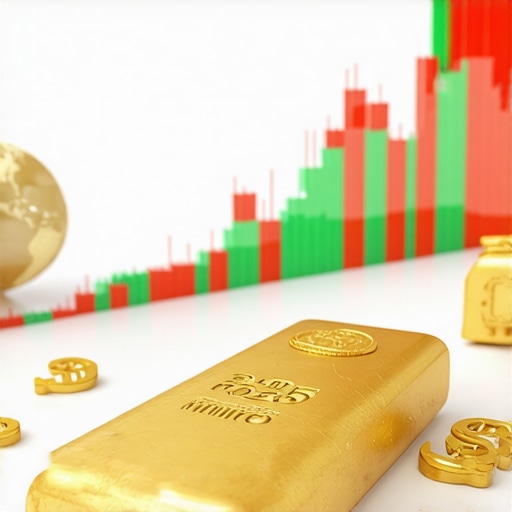Understanding the Importance of Gold Demand Trends in Investment Decisions
In the realm of investing, understanding market dynamics is crucial, and gold demand trends play a pivotal role in shaping various investment strategies. As a precious metal, gold has long been regarded as a safe haven asset, particularly during economic uncertainty. Investors are increasingly turning their attention to gold not just as a hedge against inflation but as a fundamental component of a diversified portfolio. But why exactly do gold demand trends matter for all investors?
Gold demand trends are influenced by numerous factors, including geopolitical events, global economic conditions, and changes in consumer behavior. For instance, during times of economic recession or instability, demand for gold typically spikes as investors seek stability. This phenomenon can be seen in historical contexts, where gold prices have surged amid market volatility, reinforcing its reputation as a reliable asset. Understanding these trends allows investors to anticipate market movements and make informed decisions.
The Role of Central Banks in Shaping Gold Demand
Central banks around the world play a significant role in influencing gold demand trends. Their buying and selling activities can lead to substantial shifts in gold prices and investor sentiment. For example, increased purchases of gold by central banks can signal a shift in monetary policy or a desire to diversify reserves, prompting investors to follow suit. Analyzing central bank behavior is essential for investors who want to grasp the broader implications of gold demand trends on market stability and investment opportunities.
Investor Sentiment and Market Behavior
Investor sentiment is another critical factor that can affect gold demand. During times of uncertainty, there is often a flight to safety, with gold being a preferred choice. This behavior highlights the psychological aspects of investing, where fear and uncertainty drive investors towards gold as a protective measure. Thus, keeping an eye on market sentiment and understanding how it correlates with gold demand trends can provide investors with valuable insights into when to enter or exit the market.
Moreover, gold demand is not limited to investors alone. Jewelry demand, particularly in countries such as India and China, significantly impacts global gold consumption. As cultural significance and consumer trends evolve, these markets can drastically affect overall gold demand. Therefore, recognizing these regional trends and their implications on global supply and demand dynamics is vital for investors aiming to capitalize on potential price movements.
For those looking to invest in gold, understanding these demand trends is essential. It enables investors to make informed choices and adopt strategies that align with market realities. For example, investors might consider exploring gold stocks or ETFs as part of their strategy, which can provide exposure to gold without the need to hold the physical metal. To learn more about different gold investment strategies, check out our article on best gold investment strategies for long-term gains.
Additionally, analyzing gold price forecasts can be incredibly beneficial. Understanding what drives these predictions can help investors position themselves effectively within the market. For the latest insights, read our post on 2025 gold price forecasts and gain a deeper understanding of expected movements in gold prices.
Evaluating Key Factors Driving Gold Demand
To fully appreciate why gold demand trends are vital for investment decisions, it’s essential to assess the various factors that drive these trends. Economic indicators, such as inflation rates, interest rates, and currency fluctuations, play a significant role in shaping investor behavior. When inflation rises, for instance, many investors flock to gold as a hedge against decreasing purchasing power. This reaction highlights the direct correlation between macroeconomic conditions and gold demand, making it crucial for investors to stay informed about these economic indicators.
Additionally, geopolitical tensions can dramatically influence gold prices and demand. Events such as trade wars, political instability, and conflicts often lead to increased uncertainty in the markets, prompting investors to seek refuge in gold. Understanding how global events impact gold demand trends enables investors to better navigate potential risks and make well-informed decisions about their investment portfolios.
Interpreting Gold Price Trends with Technical Analysis
Technical analysis is another valuable tool for investors interested in gold demand trends. By analyzing historical price data and chart patterns, investors can identify potential entry and exit points for their investments. This approach allows for a more nuanced understanding of market behavior, particularly in relation to gold price fluctuations.
For those looking to dive deeper into this topic, our article on analyzing gold price trends provides comprehensive insights and techniques that can enhance your investment strategy. Recognizing patterns and understanding market psychology can empower investors to act decisively, especially in volatile market conditions.
The Growing Interest in Gold ETFs and Mutual Funds
The rise of gold exchange-traded funds (ETFs) and mutual funds has also transformed how investors access gold markets. These financial products offer a convenient way to invest in gold without the need to purchase physical bullion. As investors increasingly seek ways to diversify their portfolios, understanding the dynamics of gold ETFs is crucial.
Investors should consider the differences between gold coins, bars, and ETFs. Each option carries its unique advantages and risks. For a clearer understanding of these investment types, our guide on choosing between gold bullion and coins is a great resource. By evaluating these options, investors can align their strategies with their financial goals and risk tolerance.
Impact of Cultural Factors on Gold Demand
Cultural significance also plays an important role in gold demand trends, especially in countries like India and China, where gold is not only viewed as an investment but also as a symbol of wealth and status. Festivals and weddings often drive demand surges during specific times of the year. By understanding these cultural factors, investors can better predict seasonal spikes in demand and adjust their strategies accordingly.
To further explore the implications of these cultural trends, check out our post on analyzing annual changes in gold demand trends. Understanding how cultural factors intertwine with market dynamics provides investors with a comprehensive view of gold’s role in the global economy.
In conclusion, recognizing the multifaceted nature of gold demand trends is essential for any investor looking to navigate this complex market effectively. By staying abreast of economic indicators, geopolitical events, and cultural factors, investors can make informed decisions and capitalize on opportunities as they arise. As we delve deeper into specific investment strategies, it’s vital to consider how these trends will shape the future of gold investing.
Navigating the Impact of Economic Indicators on Gold Demand Trends
As we delve deeper into the intricacies of gold demand trends, it becomes evident that various economic indicators significantly influence investor behavior. Understanding these indicators is crucial for anyone looking to capitalize on gold investments. For instance, inflation rates are a primary driver of gold demand. When inflation rises, the value of currency decreases, prompting investors to flock to gold as a hedge against eroding purchasing power. This cyclical relationship underscores the necessity for investors to monitor inflation closely.
The Influence of Interest Rates on Gold Investment Decisions
In addition to inflation, interest rates play a pivotal role in shaping gold demand trends. Lower interest rates typically make gold a more attractive investment because the opportunity cost of holding non-yielding assets like gold decreases. Conversely, when interest rates rise, investors may prefer interest-bearing assets, leading to a potential drop in gold demand. Thus, keeping an eye on central bank policies and anticipated rate changes can provide critical insights for investors. For those interested in understanding how these rates affect investment choices, our article on key market influencers affecting gold prices is a valuable resource.
Currency Fluctuations and Their Effects on Gold Prices
Currency fluctuations, particularly in the U.S. dollar, also have substantial implications for gold demand. Since gold is typically priced in dollars, a weaker dollar can make gold cheaper for foreign buyers, thus increasing demand. Investors should pay attention to the foreign exchange market as changes in currency value can lead to significant shifts in gold prices. Understanding these dynamics helps investors anticipate potential changes in their portfolios. To learn more about how currency impacts gold prices, consider exploring our insights on gold price forecasting and its key considerations.
Geopolitical Events and Their Ripple Effects on Gold Demand
Geopolitical events are another critical factor in determining gold demand trends. Events such as conflicts, trade wars, or political instability often lead to increased uncertainty in the markets, driving investors towards gold as a safe haven. For example, during periods of heightened tension, gold prices may surge as investors seek to protect their assets. Moreover, historical trends show that gold often performs well during economic downturns, making it a reliable choice for risk-averse investors. To understand the broader impact of these geopolitical events, our analysis on the role of gold in times of uncertainty offers insightful perspectives.
Exploring Regional Demand Trends in the Gold Market
Regional demand trends are also pivotal in shaping the overall landscape of gold investments. Countries like India and China have significant cultural ties to gold, leading to unique consumption patterns that can influence global demand. For instance, during wedding seasons or festivals, demand for gold jewelry increases sharply in these regions. Investors should be aware of these cultural dynamics, as they can provide opportunities for strategic investments. To keep abreast of these changes, exploring our article on analyzing annual changes in gold demand trends can offer valuable insights.
As we continue to uncover the layers of gold demand trends, it’s essential to consider how these factors interplay to affect the market. By staying informed about economic indicators, geopolitical events, and cultural influences, investors can better navigate the complexities of gold investments and position themselves for future opportunities.
Anticipating Future Gold Demand Trends and Their Implications
As we look ahead in the realm of gold investments, anticipating future gold demand trends is essential for informed decision-making. Investors often consider the broader economic landscape, as well as specific indicators that signal shifts in demand. The landscape for gold is continually evolving, with factors such as technological advances, changes in consumer preferences, and even environmental considerations influencing how gold is perceived and used.
Technological Advances and Their Effect on Gold Demand
Technological advancements play a crucial role in shaping gold demand trends. For instance, the growing use of gold in electronics and renewable energy technologies has introduced new avenues for demand. As industries increasingly focus on sustainability, the role of gold in green technologies, such as solar panels, becomes more pronounced. Investors should take note of these trends, as they can significantly impact the overall demand for gold. To understand how these developments intersect with market dynamics, our article on gold market trends provides insights into the evolving landscape.
Consumer Preferences Shaping Gold Demand
Shifts in consumer preferences also play a vital role in determining gold demand. The rise of e-commerce and changing buying habits have influenced how gold is marketed and sold. Younger generations are more inclined towards digital assets, which may lead to fluctuating interest in traditional gold investments. Understanding these consumer trends can help investors adapt their strategies accordingly. For a comprehensive overview of how to approach gold investments in changing markets, consider reading our guide on smart entry strategies for gold investments.
Gold Demand Trends in Emerging Markets
Emerging markets are increasingly becoming significant players in the global gold market. Countries such as India and China continue to drive demand due to cultural factors and rising middle-class populations seeking to invest in gold as a status symbol. The purchasing power of these nations is crucial in shaping global demand and can lead to significant price movements. Keeping a pulse on these emerging markets is essential for investors looking to capitalize on potential growth. To dive deeper into the factors influencing gold demand in these regions, our post on navigating gold ETFs for investment potential can provide valuable context.
Understanding the Impact of Inflation on Gold Demand
Inflation remains a critical factor affecting gold demand. In times of rising inflation, many investors turn to gold as a hedge, driving up demand and, consequently, prices. This relationship between inflation and gold underscores the importance of monitoring economic indicators that signal inflationary trends. Investors who can recognize these signals are better equipped to make timely investment decisions. For more on how inflation influences gold investments, check out our detailed analysis on gold price forecasting.
Conclusion: The Evolving Landscape of Gold Investments
In conclusion, understanding gold demand trends is crucial for any investor looking to navigate the complexities of the gold market effectively. From technological advancements to emerging market dynamics and inflationary pressures, numerous factors contribute to the shifting landscape of gold investments. By staying informed and adapting strategies accordingly, investors can position themselves to take advantage of opportunities in this ever-evolving market. To further enhance your knowledge, explore our collection of articles that delve into various aspects of gold investments and market analysis.
Frequently Asked Questions about Gold Demand Trends
What are the main factors driving gold demand trends?
Gold demand trends are primarily driven by economic indicators such as inflation rates, interest rates, geopolitical events, and cultural factors. Additionally, investor sentiment and central bank activities also significantly influence demand.
How does inflation affect gold demand?
Inflation typically drives up gold demand as investors seek to preserve their purchasing power. When inflation rises, many turn to gold as a hedge, leading to increased investment and higher prices.
What role do central banks play in gold demand?
Central banks are major players in the gold market, often buying gold to diversify their reserves. Their actions can significantly impact gold prices and market sentiment, influencing investor behavior.
How can geopolitical events impact gold prices?
Geopolitical events such as conflicts, trade wars, and political instability often lead to increased uncertainty in the markets. This uncertainty typically drives investors towards gold as a safe haven, resulting in surging demand and prices.
What is the significance of gold in emerging markets?
Emerging markets, particularly India and China, are crucial in shaping global gold demand due to cultural ties and increasing purchasing power. As their middle classes expand, demand for gold as an investment and status symbol continues to grow.
Are gold ETFs a good investment option?
Gold ETFs are an attractive investment option for those seeking exposure to gold without the need to physically hold the metal. They offer liquidity and convenience, making them a popular choice among investors.
How do currency fluctuations affect gold prices?
Gold is typically priced in U.S. dollars, so fluctuations in currency value can significantly impact gold prices. A weaker dollar makes gold cheaper for foreign buyers, potentially increasing demand.
What are some strategies to invest in gold?
Investing in gold can be approached through various strategies, including purchasing physical gold, investing in gold stocks, ETFs, or mutual funds, and exploring options like gold futures. Each strategy carries its unique risks and benefits.
How can I monitor gold demand trends effectively?
Investors can effectively monitor gold demand trends by staying informed about economic indicators, geopolitical events, and market sentiment. Utilizing reliable financial news sources and analytics platforms can provide valuable insights.
Authority Resources for Gold Investment Insights
To further enhance your understanding of gold demand trends and investment strategies, consider exploring the following authoritative resources:
- World Gold Council – A leading authority on gold and its investment potential, providing research and insights on global gold markets.
- Investopedia – Offers comprehensive articles on gold investing, market trends, and economic indicators affecting gold prices.
- Kitco – A trusted source for live gold prices, news, and market analysis.
- Bloomberg Markets – Provides in-depth market analysis and news related to gold and other commodities.
- Reuters Commodities – Offers updated news and insights related to commodities, including gold demand and price trends.
Conclusion: The Future of Gold Investments
In summary, understanding gold demand trends is essential for any investor looking to navigate the complexities of the gold market effectively. By considering the various factors that influence gold demand, including economic indicators, geopolitical events, and cultural influences, investors can make informed decisions. As the landscape of gold investments continues to evolve, staying informed and adapting strategies will be key to capitalizing on opportunities in this dynamic market. Explore further resources and articles to deepen your knowledge and enhance your investment strategy in gold.









